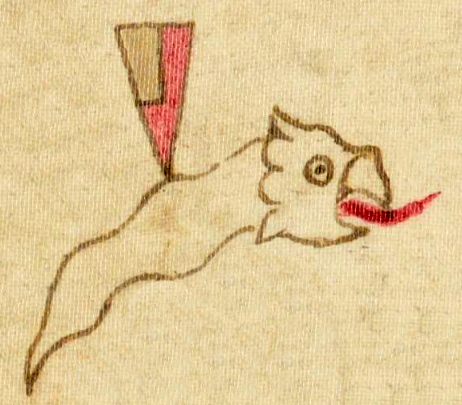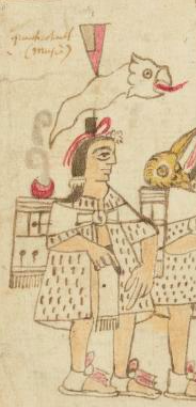Cuauhcoatl (Azca9)
This compound glyph represents a personal name, Cuauhcoatl (or perhaps Huitztli-Cuauhcoatl). It shows a profile view of the head of an eagle (cuauhtli) on a serpent (coatl), looking toward the viewer's right. The eagle's eye is open, as is its beak, and its red tongue is protruding and curving upward. The feathers on the back of its head are rather scalloped. The serpent's body is somewhat thick and short, and it does not have a rattler tail. Atop the serpent's back is a thorn (huitztli) pointing downward. This element is not represented in the name as glossed. The thorn is red and another color (brown or perhaps a faded green?).
Stephanie Wood
A note on this manuscript says this person is a "mujer" (woman). A famous woman (Chimalma or Chimalman) did play a prominent role in the migration from Aztlan. But this person is wearing a loincloth and wears a lock of hair standing up on the top of their head, tied with a red leather strap, much in the way of priests and warriors, who were mostly male.
Stephanie Wood
quauhcohuatl
Cuauhcoatl
Stephanie Wood
post-1550, possibly from the early seventeenth century
Jeff Haskett-Wood
águilas, serpientes, espinas, cohuatl, feathers, plumas, crótalos

cuauh(tli), eagle, https://nahuatl.wired-humanities.org/content/cuauhtli
coa(tl), snake or serpent, https://nahuatl.wired-humanities.org/content/coatl
huitz(tli), thorn, https://nahuatl.wired-humanities.org/content/huitztli
[Espina]-Águila-Serpiente
Stephanie Wood
The Codex Azcatitlan is also known as the Histoire mexicaine, [Manuscrit] Mexicain 59–64. It is housed in the Bibliothèque Nationale de France, and hosted on line by the World Digital Library and the Library of Congress.
https://www.loc.gov/resource/gdcwdl.wdl_15280/?sp=9&st=image
The Library of Congress is “unaware of any copyright or other restrictions in the World Digital Library Collection.” But please cite Bibliothèque Nationale de France and this Visual Lexicon of Aztec Hieroglyphs.



